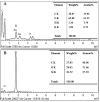Novel Low-Temperature Chemical Vapor Deposition of Hydrothermal Delignified Wood for Hydrophobic Property
- PMID: 32781550
- PMCID: PMC7463729
- DOI: 10.3390/polym12081757
Novel Low-Temperature Chemical Vapor Deposition of Hydrothermal Delignified Wood for Hydrophobic Property
Abstract
As a hydrophilic material, wood is difficult to utilize for external applications due to the variable weather conditions. In this study, an efficient, facile, and low-cost method was developed to enhance the hydrophobicity of wood. By applying the low-temperature chemical vapor deposition (CVD) technology, the polydimethylsiloxane-coated wood (PDMS@wood) with hydrophobic surface was fabricated employing dichlorodimethylsilane as the CVD chemical resource. The result of water contact angle (i.e., 157.3°) revealed the hydrophobic behavior of the PDMS@wood. The microstructures of the wood samples were observed by scanning electron microscopy and energy dispersive X-ray spectroscopy (EDS) analysis verified PDMS successfully coated on wood surfaces. The chemical functional groups of the PDMS@wood were investigated by Fourier transform infrared (FT-IR) and Raman spectra. The thermogravimetric results indicated the enhanced thermal stability of the wood after PDMS coating. In addition, the stability test of PDMS@wood indicated that the hydrophobicity properties of the PDMS@wood samples were preserved after long-time storage (e.g., 30 days). The scratch test was carried out to examine the abrasion resistance of the hydrophobic coatings on PDMS@wood surface. It was suggested that low-temperature CVD process could be a successful approach for fabricating hydrophobic wood.
Keywords: dichlorodimethylsilane; hydrophobic; low-temperature chemical vapor deposition (CVD); polydimethylsiloxane (PDMS); wood.
Conflict of interest statement
The authors declare no conflicts of interest.
Figures














References
-
- Jia S., Liu M., Wu Y., Luo S., Qing Y., Chen H. Facile and scalable preparation of highly wear-resistance superhydrophobic surface on wood substrates using silica nanoparticles modified by VTES. Appl. Surf. Sci. 2016;386:115–124. doi: 10.1016/j.apsusc.2016.06.004. - DOI
-
- Han J., Wang S., Zhu S., Huang C., Yue Y., Mei C., Xu X., Xia C. Electrospun Core-Shell Nanofibrous Membranes with Nanocellulose-Stabilized Carbon Nanotubes for Use as High-Performance Flexible Supercapacitor Electrodes with Enhanced Water Resistance, Thermal Stability, and Mechanical Toughness. ACS Appl. Mater. Interfaces. 2019;11:44624–44635. doi: 10.1021/acsami.9b16458. - DOI - PubMed
-
- Pil L., Bensadoun F., Pariset J., Verpoest I. Why are designers fascinated by flax and hemp fibre composites? Compos. Part A Appl. Sci. Manuf. 2016;83:193–205. doi: 10.1016/j.compositesa.2015.11.004. - DOI
Grants and funding
LinkOut - more resources
Full Text Sources
Research Materials

